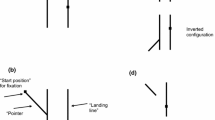Abstract.
It has been shown that a patient with visual form agnosia (DF) relies predominantly on vergence information when gauging target distance in an open-loop pointing task. This finding suggested that the programming of prehension might be severely disrupted if DF viewed target objects through ophthalmic prisms. An initial experiment showed that this prediction was not upheld; DF was able to programme reasonably accurate movements to objects located on a tabletop despite large changes in vergence angle. A second experiment, however, showed that placing the target objects at eye height whilst manipulating vergence angle caused gross disruption to prehension, with DF mis-programming the reach component in a predictable manner. Notably, the evidence for DF's reliance on vergence distance information was obtained in a task where the targets were viewed at eye height. These experiments indicate that DF uses vertical gaze angle to gauge target distance in normal prehension and suggest that this extra-retinal cue may be a useful source of distance information for the human nervous system, especially where pictorial cues are impoverished.
Similar content being viewed by others
Author information
Authors and Affiliations
Additional information
Electronic Publication
Rights and permissions
About this article
Cite this article
Mon-Williams, M., McIntosh, R.D. & Milner, D.A. Vertical gaze angle as a distance cue for programming reaching: insights from visual form agnosia II (of III). Exp Brain Res 139, 137–142 (2001). https://doi.org/10.1007/s002210000658
Received:
Accepted:
Issue Date:
DOI: https://doi.org/10.1007/s002210000658




